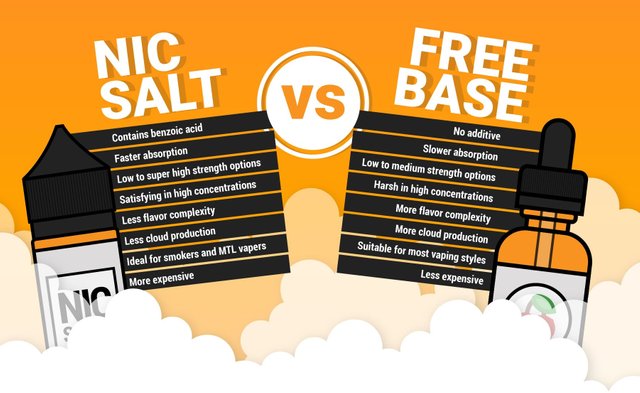Difference Between Salt Nicotine and Regular Nicotine

In the rapidly evolving world of vaping and electronic cigarettes, there is a burgeoning variety of products designed to cater to every individual's unique preferences. From flavors and devices to the type of nicotine used, the options are vast. Two terms that are often thrown around in this industry are "nicotine salts" and "freebase nicotine". But what are they, exactly? How do they differ, and what implications does this difference hold for the vaping experience? This comprehensive guide will shed light on these topics, equipping you with the knowledge you need to make informed decisions about your vaping choices.
The Nature of Nicotine
Nicotine, a naturally occurring alkaloid, is predominantly found in the tobacco plant. Known for its psychoactive effects, nicotine is the addictive component that has made tobacco products so widespread throughout history. While this substance is typically associated with cigarettes, it can exist in several forms, each offering a distinct interaction with the body's nicotine receptors. The form of nicotine used in vaping liquids - known as e-liquids - has a profound impact on the overall vaping experience. The focus here is on the two primary types of nicotine used in the vaping industry: freebase nicotine (the standard type) and salt nicotine (a relatively new development).
Read more:
Nicotine: Everything You Need to Know
Freebase Nicotine: The Traditional Route
Freebase nicotine is the purest form of nicotine. It's been chemically manipulated to enhance its potency, thereby making it more addictive. This form of nicotine has been the tobacco industry's standard since the 1960s, thanks to the work of Phillip Morris, the parent company of Marlboro. To create a stronger 'kick' from their cigarettes, they increased the bioavailability of nicotine by manipulating its pH levels. Bioavailability refers to how efficiently a substance can be absorbed into the body. Freebase nicotine, by nature of its increased alkalinity, is absorbed into the body quicker and delivers a more potent hit than other forms of nicotine.
Nicotine Salts: A Newer Trend
Nicotine salts are a newer innovation in the world of vaping. Unlike freebase nicotine, nicotine salts mirror the natural state of nicotine found in the tobacco leaf. In this form, nicotine carries both positive and negative charges, making it a 'salt.' However, these charged particles are not absorbed as efficiently in our bodies, which means they provide a less potent hit compared to freebase nicotine.
To make nicotine salts more effective, manufacturers introduce benzoic acid into the mix. This acid serves to lower the pH of nicotine salts, reducing their overall alkalinity. This chemical reaction results in a smoother throat hit, enabling vapers to enjoy higher concentrations of nicotine without the accompanying harshness. Therefore, nicotine salts have been engineered to offer a more comfortable and enjoyable experience, even at high nicotine levels, closely mimicking the sensation of traditional smoking.
Read more:
Nicotine: What are Nicotine Salts?
Freebase Nicotine vs. Salt Nicotine: The Core Difference
At the heart of the distinction between freebase nicotine and salt nicotine are their pH levels, chemical structure, and the unique vaping experiences they each provide. Salt nicotine, characterized by its lower pH levels, delivers a smooth vaping experience even at high nicotine concentrations. On the other hand, freebase nicotine, with its elevated pH levels, can produce a harsher throat hit as the concentration of nicotine increases.
Another key difference is that salt nicotine requires higher temperatures to vaporize, and it's absorbed into the human body at a different rate than freebase nicotine. The advent of advanced vaping devices has made it possible to efficiently vaporize salt nicotine, paving the way for it to become a popular choice for individuals seeking higher nicotine concentrations without the harsh aftereffects.
Guiding Your Vaping Choice
The choice between freebase nicotine and salt nicotine ultimately comes down to your personal needs and preferences. If you're a heavy smoker transitioning to vaping, you might prefer the sensation offered by nicotine salts, which closely replicates that of traditional cigarettes. Conversely, if you're a recreational vaper, who views vaping as a hobby rather than a substitute for smoking, you might prefer freebase nicotine. Its range of concentration levels offers more control over your nicotine intake, allowing you to taper down your usage as you see fit.
It's important to remember that vaping, while generally considered less harmful than smoking, still carries potential health risks. Long-term effects of vaping are still being studied, and we don't yet have a complete picture of its impact on our health. So, regardless of your choice of nicotine, always prioritize your wellbeing. Consult with a healthcare professional if you're considering significant changes to your nicotine consumption habits.
Article Source:
Nicotine: WHAT IS THE DIFFERENCE BETWEEN SALT NICOTINE AND REGULAR NICOTINE?
It's all about pH levels, chemical structure, and the kind of vape experience you're after.
Salt nicotine is easier on the throat, even with high nicotine levels, thanks to a pH tweak. Freebase, on the other hand, can get harsh as the nicotine level climbs. Salt nicotine needs more heat to vaporize and hits differently in the body.
Your choice between the two boils down to personal preference. If you're quitting smoking, salt nicotine might be your go-to. If vaping is more of a hobby, freebase gives you control over nicotine levels. And if you're ever up for exploring vape juices that smell better (even for non-smokers) and come with zero nicotine, check out https://www.driplocker.com .